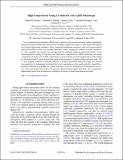Files in this item
High cooperativity using a confocal-cavity–QED microscope
Item metadata
| dc.contributor.author | Kroeze, Ronen M. | |
| dc.contributor.author | Marsh, Brendan P. | |
| dc.contributor.author | Lin, Kuan-Yu | |
| dc.contributor.author | Keeling, Jonathan | |
| dc.contributor.author | Lev, Benjamin L. | |
| dc.date.accessioned | 2023-05-12T09:30:09Z | |
| dc.date.available | 2023-05-12T09:30:09Z | |
| dc.date.issued | 2023-05-11 | |
| dc.identifier | 284071496 | |
| dc.identifier | 5b4f543f-8876-4c13-a7a2-cfaa3e284a9e | |
| dc.identifier | 85163411924 | |
| dc.identifier.citation | Kroeze , R M , Marsh , B P , Lin , K-Y , Keeling , J & Lev , B L 2023 , ' High cooperativity using a confocal-cavity–QED microscope ' , PRX Quantum , vol. 4 , no. 2 , 020326 . https://doi.org/10.1103/PRXQuantum.4.020326 | en |
| dc.identifier.issn | 2691-3399 | |
| dc.identifier.other | ArXiv: http://arxiv.org/abs/2212.06716v1 | |
| dc.identifier.other | ORCID: /0000-0002-4283-552X/work/135019063 | |
| dc.identifier.uri | https://hdl.handle.net/10023/27595 | |
| dc.description | Funding: The authors acknowledge funding support from the Army Research Office, NTT Research, and the QNEXT DOE National Quantum Information Science Research Center. B.M. acknowledges funding from the Q-NEXT DOE National Quantum Information Science Research Center and the NSF Graduate Research Fellowship. | en |
| dc.description.abstract | Cavity quantum electrodynamics (QED) with cooperativity far greater than unity enables high-fidelity quantum sensing and information processing. The high-cooperativity regime is often reached through the use of short single-mode resonators. More complicated multimode resonators, such as the near-confocal optical Fabry-Prot cavity, can provide intracavity atomic imaging in addition to high cooperativity. This capability has recently proved important for exploring quantum many-body physics in the driven-dissipative setting. In this work, we show that a confocal-cavity–QED microscope can realize cooperativity in excess of 110. This cooperativity is on par with the very best single-mode cavities (which are far shorter) and 21 times greater than single-mode resonators of similar length and mirror radii. The 1.7-μm imaging resolution is naturally identical to the photon-mediated interaction range. We measure these quantities by determining the threshold of cavity superradiance when small optically tweezed Bose-Einstein condensates are pumped at various intracavity locations. Transmission measurements of an ex situ cavity corroborate these results. We provide a theoretical description that shows how cooperativity enhancement arises from the dispersive coupling to the atoms of many near-degenerate modes. | |
| dc.format.extent | 19 | |
| dc.format.extent | 2142764 | |
| dc.language.iso | eng | |
| dc.relation.ispartof | PRX Quantum | en |
| dc.subject | QC Physics | en |
| dc.subject | T-NDAS | en |
| dc.subject | MCC | en |
| dc.subject.lcc | QC | en |
| dc.title | High cooperativity using a confocal-cavity–QED microscope | en |
| dc.type | Journal article | en |
| dc.contributor.institution | University of St Andrews. School of Physics and Astronomy | en |
| dc.contributor.institution | University of St Andrews. Centre for Designer Quantum Materials | en |
| dc.contributor.institution | University of St Andrews. Condensed Matter Physics | en |
| dc.identifier.doi | 10.1103/PRXQuantum.4.020326 | |
| dc.description.status | Peer reviewed | en |
This item appears in the following Collection(s)
Items in the St Andrews Research Repository are protected by copyright, with all rights reserved, unless otherwise indicated.

